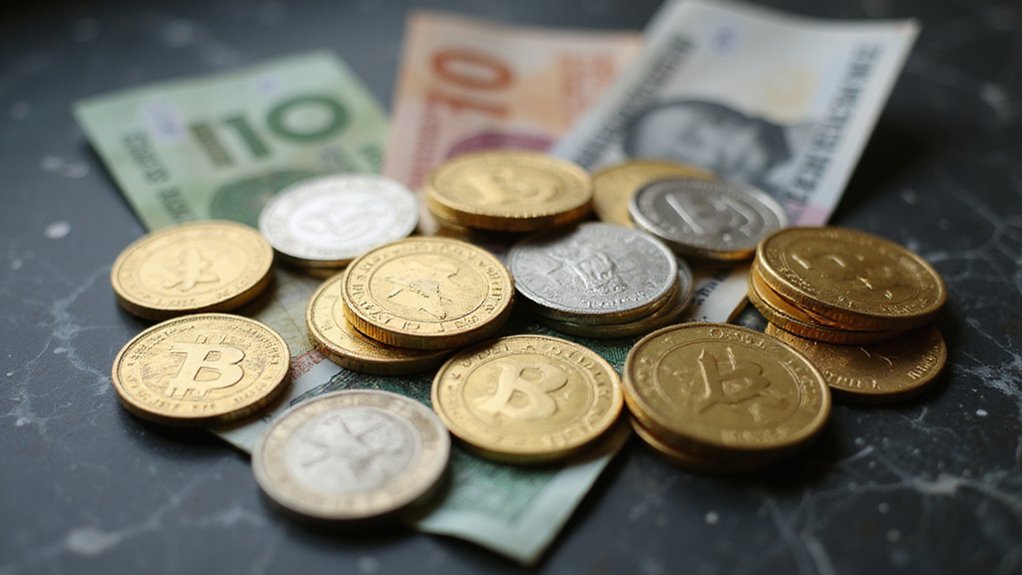The altcoin landscape offers compelling opportunities beyond Bitcoin’s milestone achievements, with Ethereum maintaining its $307 billion dominance in smart contracts while Solana ($78.22 billion) excels in DeFi efficiency despite occasional technical hiccups. Monero’s 100% year-to-date surge reflects privacy demand amid regulatory scrutiny, while Hyperliquid’s $11.43 billion valuation signals institutional appetite for emerging protocols. Each presents distinct risk-reward profiles—from Ethereum’s established monopoly to Avalanche’s traditional finance integration—requiring investors to understand the specific problems these networks solve better than existing solutions.

While Bitcoin commands headlines with its triumphant march past $100,000 and trillion-dollar market capitalization, the altcoin universe presents a more nuanced—and perhaps more compelling—investment landscape for those willing to venture beyond the digital gold standard.
Ethereum remains the institutional darling at $307 billion market capitalization, trading near $2,544 while maintaining its stranglehold on smart contract infrastructure. The network’s continuous technological upgrades and developer adoption create what amounts to a digital monopoly on decentralized applications—though monopolies in crypto tend to be rather more fragile than their traditional counterparts. The platform’s dominance extends into the DeFi ecosystem, where smart contracts enable peer-to-peer financial services without traditional banking intermediaries.
Ethereum’s smart contract dominance creates a digital monopoly—though crypto monopolies prove far more fragile than traditional counterparts.
For those seeking explosive growth potential, Monero‘s privacy-focused proposition has delivered spectacular returns exceeding 100% year-to-date, reaching approximately $400 per coin. The cryptocurrency’s cryptographic anonymization technology addresses genuine market demand, though regulatory scrutiny remains an ever-present sword of Damocles.
Hyperliquid represents the newer generation of Layer-1 blockchains, achieving a remarkable $11.43 billion market capitalization despite trading at just $34.22 per token. Its capped supply of one billion coins and advanced transaction capabilities have generated impressive 46% year-to-date gains, suggesting institutional recognition of its technological merits.
Binance Coin continues benefiting from ecosystem expansion, maintaining a $91.18 billion market cap at $647.26 per token. The exchange token model—where success hinges entirely on the parent platform’s dominance—creates concentrated risk that investors either embrace or avoid entirely.
Solana’s high-throughput blockchain commands $78.22 billion in market capitalization, trading around $148.44 while dominating DeFi and NFT sectors. The network’s combination of speed and cost efficiency addresses Ethereum‘s most glaring weaknesses, though technical outages occasionally remind users that newer doesn’t always mean more reliable.
Avalanche rounds out the selection with its $7.7 billion market cap and $18.27 price point, emphasizing interoperability and institutional adoption. The platform’s focus on traditional finance integration represents a pragmatic approach to blockchain utility.
Each altcoin presents distinct risk-reward profiles, from Ethereum’s established dominance to Hyperliquid‘s emerging potential. The key lies in understanding that altcoin success often depends on solving specific problems better than existing solutions—a surprisingly rare occurrence in crypto’s feature-rich landscape. Market volatility remains a defining characteristic, with wild price swings continuing to shape investor sentiment throughout 2025.
Frequently Asked Questions
How Do I Store Altcoins Safely After Purchasing Them?
Altcoin storage demands a risk-appropriate approach: hardware wallets like Ledger Nano X or NGrave Zero offer ideal security for substantial holdings, while hot wallets suffice for trading portions.
Multi-signature configurations add institutional-grade protection, though perhaps overkill for modest investments.
Paper wallets serve long-term storage—assuming one trusts their organizational skills.
Decentralized networks like Arweave provide encrypted backup redundancy, because traditional cloud storage apparently lacks sufficient irony for cryptocurrency enthusiasts seeking true decentralization.
What Percentage of My Portfolio Should I Allocate to Altcoins?
Most prudent investors allocate 10-15% of their cryptocurrency holdings to altcoins—meaning if one maintains the recommended 5% portfolio allocation to crypto overall, altcoins represent roughly 0.5-0.75% of total net worth.
This modest exposure acknowledges altcoins’ superior growth potential while respecting their tendency toward spectacular implosions.
Given the storage complexities discussed previously, such conservative positioning seems almost quaint until one witnesses another promising project vanish overnight.
When Is the Best Time to Sell Altcoins During a Bull Run?
The ideal exit timing hinges on recognizing market euphoria—when taxi drivers dispense crypto advice and obscure tokens achieve billion-dollar valuations.
March historically triggers selloffs due to tax considerations, while technical indicators like RSI divergence and volume spikes signal momentum shifts.
Staged profit-taking proves superior to timing perfect tops (an exercise in futility).
Smart money exits incrementally at resistance levels, avoiding the emotional paralysis that accompanies parabolic moves and inevitable corrections.
How Do I Track Altcoin Performance and Set Price Alerts?
Investors typically employ extensive portfolio platforms like CoinStats or CoinTracking to monitor altcoin performance across multiple exchanges and wallets simultaneously.
These tools provide real-time price data for thousands of assets, historical analytics, and importantly—customizable price alerts based on percentage thresholds or absolute values.
Most platforms offer cross-device notifications (mobile and desktop) while supporting complex multi-condition triggers that account for volume spikes and market cap changes alongside basic price movements.
What Are the Tax Implications of Buying and Selling Altcoins?
The IRS treats every altcoin transaction—regardless of magnitude—as taxable property disposal, creating labyrinthine reporting obligations.
Short-term gains face ordinary income rates (up to 37%), while long-term holdings enjoy preferential treatment (0-20%).
The incoming 2025 Form 1099-DA requirements and wallet-by-wallet accounting mandates will eliminate whatever informality previously existed.
Mining rewards, staking income, and airdrops trigger immediate ordinary income recognition at fair market value—because apparently nothing crypto-related escapes taxation.









